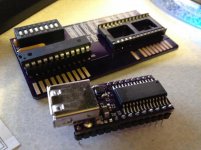Hi
Couple of queries
Can i use a serial usb adapter run to a usb hub?
Will it allow hot swap?
Alternately can i use a usb to FDD/IDE/SATA adapter directly to an I/O card. (it would be run 'backwards')
I have just aquired a FDD & all in 1 floppy drive, which has the FDD plug but also a 9-pin usb header. It will need an adapter of some sort to run the usb side.
Defeated the purpose really. And be as cheap as possible. All usb cards i have found are PCI not EISA.
Andy
Couple of queries
Can i use a serial usb adapter run to a usb hub?
Will it allow hot swap?
Alternately can i use a usb to FDD/IDE/SATA adapter directly to an I/O card. (it would be run 'backwards')
I have just aquired a FDD & all in 1 floppy drive, which has the FDD plug but also a 9-pin usb header. It will need an adapter of some sort to run the usb side.
Defeated the purpose really. And be as cheap as possible. All usb cards i have found are PCI not EISA.
Andy

